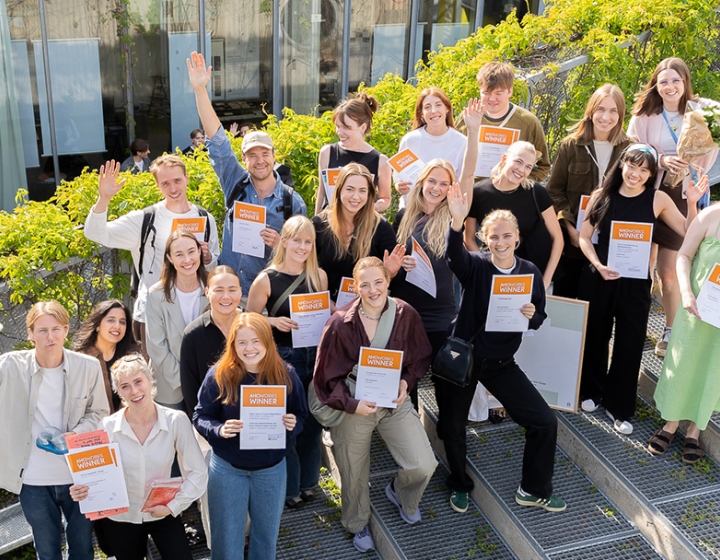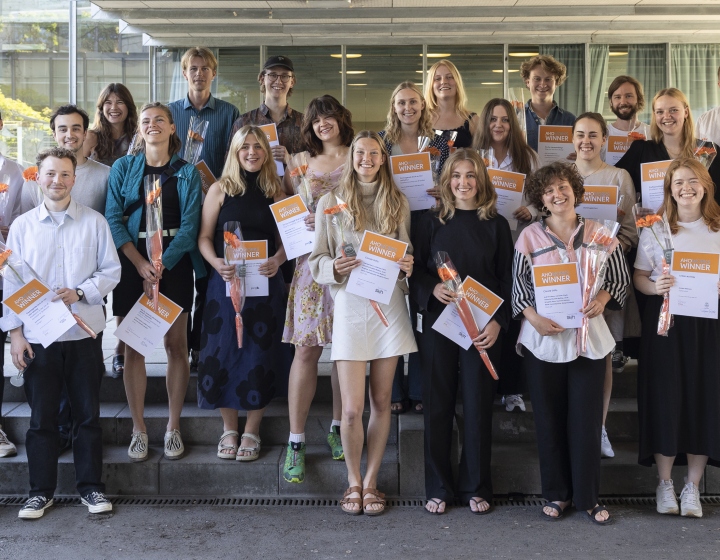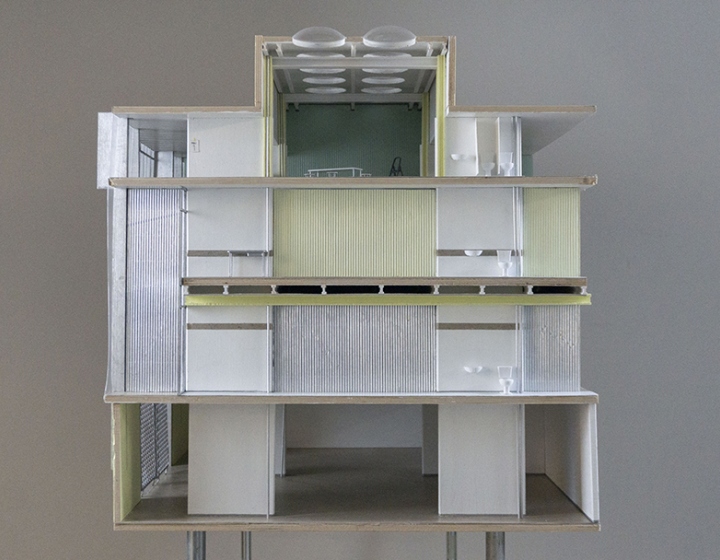The world is calling for you and your talents
20. January, 2025
GRADUATION SPEECH: May you face challenges with hope, seize opportunities with determination, and craft a future beyond your greatest dream, encourages rector Irene Lønne in her graduation speech at AHO.
Text: Irene Alma Lønne, Rector, The Oslo School of Architecture and Design (AHO)
Dear Graduates,
It is a true joy to stand here on this momentous day and have the privilege of sending you off into the world with these words. It is a great honor.
The World Has Changed
We’ve just stepped into a new year—2025. The start of a new year always invites reflection and contemplation. Traditionally, many of the world’s leaders deliver New Year’s speeches, welcoming the year ahead, reflecting on the past, and looking toward the future.This year, I was particularly struck by the somber tone of many speeches—the gravity, the number of simultaneous crises, and the genuine fear of war and collapse. A common thread in the Nordic speeches was the mention of crises, but also of hope.
“The world has changed,” said Danish Prime Minister Mette Frederiksen, opening her speech with: How does one begin a New Year’s speech in such a turbulent world? She soon described our times with the words, “Dark forces have united.”
A Defense of the Future
Kristian Leth, a New York-based author and musician , wrote the book Hope: A Defense of the Future a few years ago. In an article, he reflects on the grim outlooks expressed in the New Year speeches, stating: “We believe we’re living at a pivotal moment in history, facing war, the climate crisis, and the rise of trumpisme. “It feels as though we’re standing on the edge of an abyss,”
“But humanity has always felt this way,” he suggests.
“Our narratives about the world’s end are deeply rooted in moral and Christian thought patterns, both of which hinder hope and action. The story that everything is heading for disaster, with something even worse ahead, can be traced back to early Christianity, according to Leth.
“Back then, it was believed that the world would soon end. Though we are still here thousands of years later, the narrative persists because it helps us make sense of an overwhelming world."
Leth sees a lack of hope everywhere. Often, it’s about how we “extrapolate” (a mathematical term meaning to infer the unknown based on known information). He believes we take this extrapolation to the extreme.
“I try to dismantle the grand narrative and suggest that it’s entirely human to look at the world and feel overwhelmed. It’s part of the human condition. It’s not a sign that we’ve truly understood anything.”
In a Time Like This
In Another Nordics New Year speech, Norwegian King Harald also spoke of hope – he quoted Leonard Cohen: "There is a crack in everything. That’s how the light gets in." And today, I want to say to you that hope is here, and I believe there is much hope awaiting you.
How does one draft a graduation speech in a time like this?
What future lies ahead?
Perhaps rectors have always pondered these questions, and it’s nothing new.
Yet, the times have indeed changed. The world you are stepping into is different, and so is our professions.
The roles of architects, landscape architects, and designers have evolved over the years. Traditional jobs are disappearing entirely or partially. Our graduates no longer find jobs as quickly as before. But at the same time, new opportunities are emerging, new paths are opening, and entirely new fields are being explored.
New Paths for Architects and Designers
A few weeks ago, I came across a full-page article in the Danish newspaper Politiken about the role of architects in rebuilding Ukraine—a rare article about architecture that wasn’t reviewing a building or critiquing urban development. It was about hope and action, highlighting how our professions are central to addressing the crises we face today. This represents a new way of understanding our fields. The article focus on how a small group of architects under Architects Without Borders – a humanitarian organization – and on innovative ways of using materials:
Ukrainian architect Olena Ruban said “Despite the war, we have already started rebuilding our country. I firmly believe that the future lies in sustainable construction, because we can no longer continue to exploit the planet”
According to the UN, over 2 million homes have been damaged or destroyed in Ukraine since the invasion in February 2022. Additionally, countless other buildings have been affected. Rebuilding them poses a significant challenge for the climate if done with conventional materials. This presents both challenges and opportunities to develop new, sustainable solutions. And Ukraine is sadly not the only place in the world were rebilding will be needed.
In other parts of the world, discussions around halting and stopping new construction altogether are leading to new ways of viewing and understanding transformation and the reuse of existing structures.
Hope and Action
But you are well aware of this—not least because you are deeply engaged with the world around you. You bring new ideas and solutions for tackling problems and driving necessary change. Your graduation projects are clear evidence of this—they speak volumes. And that is hope, because, as Kristian Leth suggests, hope is action.Your projects demonstrate that you have that action-oriented mindset!
Your projects span a wide range of proposals on how we can address and solve key societal challenges—challenges where architects, designers, and landscape architects play crucial roles. Some focus on transforming existing buildings, others on integrating sustainability in new ways. Some tackle issues like health, agriculture, and food production. Several critically examine existing plans and offer new, alternative solutions.
All in all, I see a generation deeply engaged with the world we live in, actively considering how your expertise can contribute to and drive positive change.
You are a reflection of your time.
Strong Voices of Change
Another perspective is the emergence of strong new voices in architecture and design, showing that new paths and opportunities await you. Two architects have made it onto Times Magazine's list of the 100 most influential people in the world in 2024. The architects are included alongside world leaders, artists, and sports stars in the annually published list of people deemed the world's most influential.
Ghanaian-Scottish architect, academic, and novelist Lesley Lokko, named as a pioneer, was described like this:
“Her extraordinary trajectory eviscerates the old world that had maintained a dominant perspective in architecture—one that she calls ‘a singular, exclusive voice, whose reach and power ignores huge swathes of humanity ... as though we have been listening and speaking in one tongue only.’ Now, we hear hers. Lesley creates new landscapes to re-imagine access and impact and vision and vibrant futures. Her presence in the world of architecture is the very foundation upon which fresh perspectives and passions will flourish. She is indeed a force of nature. A force for change. A force for good.”
Named as an innovator on the same list is Marina Tabassum, a Bangladeshi architect, praised for her altruistic approach to her work.
About her it was stated:
"Altruism isn't typically a term attributed to award-winning architects—a profession where ‘signature’ has become a common adjective—but Marina Tabassum isn't typical,"
"She has developed houses that are cost-effective and easy to move—clearly, buildings shouldn't just breathe; they should avoid getting their feet wet. While she practices very locally, she teaches, lectures, and is recognized internationally, modeling architecture not as an individual signature but as a collective Esperanto."
These examples embodies the trends and tendencies of our time.
Unknown paths
The world is calling for you and your talents – and these examples show that both the small and large steps you take will make a difference and contribute to the change we need. I see that hope, I see your potential, and I wish for you to harness the superpower inherent in our professions and seize the opportunities in your own unique ways. Your path may not be the traditional or expected one, but my hope is that this will motivate you to explore new and perhaps unknown paths, inspiring others to change as well.
Trust in your abilities, be open to new experiences, and let your passion for design, architecture, and landscape architecture guide you to your future.
Dear graduates, your journey with us as students has come to an end. We have truly enjoyed getting to know you, and we are grateful that you chose to study here at AHO.
You are now no longer our students – you are our colleagues, and I can say on behalf of us all that we hope you will come back to us.
We hope to collaborate with you in your future professions, to see you return for further education, and perhaps as teachers or PhD students. We look forward to your participation in critical debates about where our professions and educations are heading, and to seeing you at exhibitions, lectures, and much more.
In short, we look forward to seeing you in the future.
So may you face challenges with hope, seize opportunities with determination, and craft a future beyond your greatest dream.



